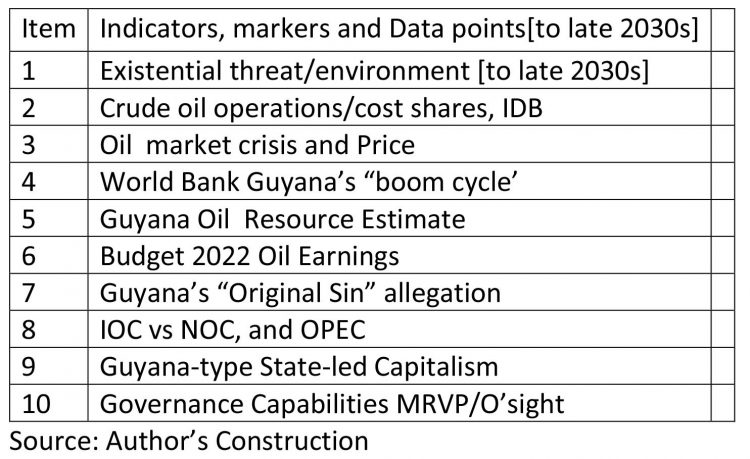Introduction
This week’s column and the ones immediately following are devoted to linking the two areas into which I have codified my presentation thus far. As indicated, this is aimed at providing a “general overarching formulation of the ruling dynamic governing the emergence of Guyana’s infant oil and gas sector”. As shown last week that formulation is encapsulated in two sets of Pillars, which I have labelled, A&B and C&D. To recall, A&B is a theoretical grouping, which I have already presented in recent columns. These columns come before columns on the latter grouping though, as the latter grouping is to be addressed immediately after my completion of the presentation on the linkage between the two groupings. I do this utilizing observations on a sample of 10 key indicators, markers, and data points, that I have introduced over the years and which represent the likely state of Guyana’s oil and gas sector, going forward over the next decade and a half.
Schedule 1: Sample, 10 Indicators/Markers/Data Points

Item 1 refers to the existential threat created by Venezuela’s territorial claims on Guyana over the next decade and a half as well as a similar time- frame existential threat, but this time posed by a catastrophic environmental event happening in Guyana’s offshore petroleum operations. Item 2 refers to the modelled shares of cost of operations projected by the IDB to 1925/6. Item 3 refers to the ruling oil market price over the timeline. Item 4 refers to the boom cycle, which the World Bank has projected for Guyana going forward. Item 5 provides a realistic handle on Guyana’s oil resources.
Item 6 refers to the key projections on offer by the Government as indicated in its National Budget 2022. Item 7 refers to a defect in the PSA that relates to the acquisition and regulation of exploration licensing. Item 8 refers to the private public distribution of global crude oil production. Item 9 refers to the nature of Guyana’s capitalist system. Finally, Item 10 speaks to the petroleum governance framework in Guyana.
While I have over the years offered numerous markers/specifics and data points, the sample I provide is enough to capture the state of play in Guyana’s emerging petroleum sector. I therefore use the sample to illustrate the prevailing situation.
Existential threats, Item 1
On December 11, 2016, I had presented a column entitled The Dark Side of Guyana’s Commercial Oil & Gas Discovery: Venezuela’s Territorial Aggression. There I referenced Guyana’s geo-strategic challenges arising from Venezuela’s aggression in support of its unworthy claim that the Guyana oil and gas finds are located in its territorial waters. I had posited, this geo-strategic aspect is potentially, existential for the sector. And, the basis for this claim is captured in the following quotation from Michael Klare’s , Blood and Oil (2004):
“Conflict over control of oil supplies has been a persistent feature of international affairs since the beginning of the 20th century. Such conflict varies … ranging from territorial disputes over the possession of oil-laden border areas … to major interstate wars over the control of vital oil zones”.
Based on this I admitted that, the close historical connection between oil, border conflicts, and war is widely accepted by specialists/analysts in the fields of international affairs and the political economy of oil.
Venezuela aggression
While not delving into the historiography of Guyana – Venezuela border relations, I had noted Guyana’s allegation of Venezuelan aggression is on its own, sufficient, to establish that geo-strategic concerns have already inserted themselves in the transition from ongoing discoveries to effective development of oil and gas production and export. In this sense therefore, it is wise to be guided by the historical evidence indicating the close connection between oil, located in contested border areas, conflicts, and inter-state wars.
For sure, the Government of Guyana has indeed publicized several aggressions which Venezuela has directed against the country. Their scope is wide, thereby suggesting great complexity. Among the more important aggressions are Venezuela’s: 1) deliberate exercise of an effective veto over Guyana’s general development and specific projects through invoking territorial claims on Guyana 2) active discouragement of investors, (as particularly evident in the energy sectors, oil and hydropower) and, 3) challenges to Guyana’s sovereignty in claiming about two-thirds of the territory it has held at the time of its Independence!
Because of the vast disparity in territorial size, economic capacity, and military capability between Venezuela and Guyana such actions have disproportionately impacted negatively on Guyana, as it has to carry the additional burden of guarding its sovereignty in an asymmetric environment. Basically, Venezuela is the fifth largest nation in South America, while Guyana is one of the smallest!
When examining the historical lessons of oil and conflict, it further emerges that domestic economic circumstances in the aggressor country [or the one claiming the other’s territory], plays crucial roles in framing outcomes. Of final note, traditionally, Venezuela has been a major player in the global oil market and a leading member of OPEC. It is also one of the Top 4 holders of oil reserves. Sadly, despite the foregoing, Venezuela is in the grip of a deep crisis facing both oil and its wider economy.
Conclusion
Next week I continue from the second leg of the existential threat.






